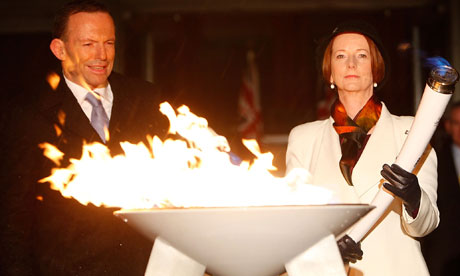
The chain of light began long before darkness reached the UK. As twilight fell across the Pacific, New Zealand, Tonga and Australia took turns to start the relay of 4,200 beacons lit to mark the Queen's diamond jubilee.
The first beacon was lit in the town of Blenheim in Marlborough on the northernmost tip of New Zealand's South Island.
In Tonga it was Boy Scouts and Girl Guides who lit the torches while in Canberra the honour went to Julia Gillard, the Australian prime minister, who lit a beacon at Parliament house.
Other beacon sites included the Treetops hotel in Kenya, where the then Princess Elizabeth heard that her father, King George VI, had died in 1952.
In Britain, the network of beacons – the nation's oldest signalling system – was prepared for a diamond jubilee renaissance as night fell.
The ancient network has been much lauded in the past. Lord Macaulay, the 19th century poet and politician, wrote of Skiddaw's red glare and the rousing of 12 fair counties from Malvern's lonely height in his poem The Armada.
On Monday, the network was poised to be reborn with playful 21st century additions.
The militia mobilised by threats such as the Spanish Armada in the 1500s would have been startled by some of the modern pyres: a vast model of Britannia in East Sussex, a pile of redundant hospital beds in Manchester and six hot air balloons – claimed to form the highest of all the beacons – thousands of feet above Bath.
The beacon mania astonished the organisers of the event, one in a series of royal, millennial and other national bunfights that have scarcely allowed braziers to cool down in the past two decades.
Bruno Peek, pageant-master of the beacons at the 2002 golden jubilee and now again, said: "We set out to mark the year by having 2,012 beacons worldwide, which would have been the most ever for this type of occasion.
"To have reached double that figure reflects the national and worldwide respect and affection for the Queen and the desire to celebrate her 60-year reign."
The UK's illuminations, which include hundreds of other bonfires which have not applied for official designation, were largely sited on hills – including almost all the Armada sites.
Fire also danced atop 600 churches and marched from sea to sea along Hadrian's Wall.
A second flotilla, likely to enjoy much better weather than the London one, was set to sail the Humber estuary between fires burning on either bank.
Conventional lighting methods will ignite most of the beacons, in the hands of lucky schoolchildren in some places and veterans in others.
At Malvern's Worcestershire beacon, the lonely height of which Macaulay wrote, a picnic will end with 77-year-old Tony Cotgreave igniting the beacon, as he did at the Queen's Coronation in 1953 when a teenage scout.
Lighthouses will also form part of the chain, including the South Foreland tower in Kent, which has not been lit for more than 20 years.
Finally, at 10.30pm after the huge picnic and concert at Buckingham Palace, the subject of all the merrymaking is due to place a crystal glass "diamond" into a special pod to light the final beacon in the Mall.

